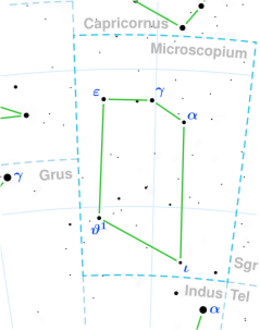Astronomy:HD 198357
| Observation data Epoch J2000.0 Equinox (celestial coordinates) | |
|---|---|
| Constellation | Microscopium |
| Right ascension | 20h 51m 00.75817s[1] |
| Declination | −37° 54′ 47.9922″[1] |
| Apparent magnitude (V) | 5.50±0.01[2] |
| Characteristics | |
| Spectral type | K3 III[3] or K3 II[4] |
| B−V color index | +1.38[5] |
| Astrometry | |
| Radial velocity (Rv) | 16.5±2.9[6] km/s |
| Proper motion (μ) | RA: −7.436[1] mas/yr Dec.: −17.374[1] mas/yr |
| Parallax (π) | 5.7348 ± 0.0797[1] mas |
| Distance | 569 ± 8 ly (174 ± 2 pc) |
| Absolute magnitude (MV) | −0.75[7] |
| Details | |
| Mass | 1.81±0.44[8] M☉ |
| Radius | 37.8±1.9[9] R☉ |
| Luminosity | 417+16−15[1] L☉ |
| Surface gravity (log g) | 1.06[10] cgs |
| Temperature | 4,318±51[11] K |
| Metallicity [Fe/H] | −0.12[10] dex |
| Rotational velocity (v sin i) | <1.0[12] km/s |
| Other designations | |
| Database references | |
| SIMBAD | data |
HD 198357 (HR 7971; 28 G. Microscopii) is a solitary star located in the southern constellation Microscopium. It is faintly visible to the naked eye as an orange-hued point of light with an apparent magnitude of 5.50.[2] Gaia DR3 parallax measurements imply a distance of 569 light-years[1] and the object is currently receding with a heliocentric radial velocity of 16.5 km/s.[6] At its current distance, HD 198357's brightness is diminished by 0.18 magnitudes due to interstellar extinction[14] and it has an absolute magnitude of −0.75.[7]
HD 198357 has a stellar classification of K3 III,[3] indicating that it is an evolved K-type giant star. David Stanley Evans gave a classification of K3 II, indicating a more evolved bright giant.[4] It has 1.81 times the mass of the Sun[8] but it has expanded to 37.8 times the radius of the Sun.[9] It radiates 417 times the luminosity of the Sun[1] from its photosphere at an effective temperature of 4,318 K.[11] HD 198357 is slightly metal deficient with an iron abundance three-quarters that of the Sun or [Fe/H] = −0.12[10] and it spins too slowly for its projected rotational velocity to be measured accurately.[12] HD 198357 has a peculiar velocity of 27.7+3.9
−4.1 km/s, indicating that it may be a runaway star (46% chance).[15]
References
- ↑ Jump up to: 1.0 1.1 1.2 1.3 1.4 1.5 1.6 Vallenari, A. et al. (2022). "Gaia Data Release 3. Summary of the content and survey properties". Astronomy & Astrophysics. doi:10.1051/0004-6361/202243940 Gaia DR3 record for this source at VizieR.
- ↑ Jump up to: 2.0 2.1 Høg, E.; Fabricius, C.; Makarov, V. V.; Urban, S.; Corbin, T.; Wycoff, G.; Bastian, U.; Schwekendiek, P. et al. (March 2000). "The Tycho-2 catalogue of the 2.5 million brightest stars". Astronomy and Astrophysics 355: L27–L30. ISSN 0004-6361. Bibcode: 2000A&A...355L..27H.
- ↑ Jump up to: 3.0 3.1 Houk, N. (1982). Michigan Catalogue of Two-dimensional Spectral Types for the HD stars. Declinations −40° to −26°. 3. Bibcode: 1982mcts.book.....H.
- ↑ Jump up to: 4.0 4.1 Evans, D. S. (1966). "Fundamental data for Southern stars (6th list).". Royal Greenwich Observatory Bulletins 110: 185. Bibcode: 1966RGOB..110..185E.
- ↑ Lake, R. (1965). "Photometric Magnitudes and Colours for Bright Southern Stars (Sixth List)". Monthly Notes of the Astronomical Society of South Africa 24: 41. ISSN 0024-8266. Bibcode: 1965MNSSA..24...41L.
- ↑ Jump up to: 6.0 6.1 Gontcharov, G. A. (November 2006). "Pulkovo Compilation of Radial Velocities for 35,495 Hipparcos stars in a common system". Astronomy Letters 32 (11): 759–771. doi:10.1134/S1063773706110065. ISSN 1063-7737. Bibcode: 2006AstL...32..759G.
- ↑ Jump up to: 7.0 7.1 Anderson, E.; Francis, Ch. (May 2012). "XHIP: An extended hipparcos compilation". Astronomy Letters 38 (5): 331–346. doi:10.1134/S1063773712050015. ISSN 1063-7737. Bibcode: 2012AstL...38..331A.
- ↑ Jump up to: 8.0 8.1 Hohle, M.M.; Neuhäuser, R.; Schutz, B.F. (April 2010). "Masses and luminosities of O- and B-type stars and red supergiants". Astronomische Nachrichten 331 (4): 349–360. doi:10.1002/asna.200911355. ISSN 0004-6337. Bibcode: 2010AN....331..349H.
- ↑ Jump up to: 9.0 9.1 Kervella, P.; Thévenin, F.; Di Folco, E.; Ségransan, D. (October 2004). "The angular sizes of dwarf stars and subgiants". Astronomy & Astrophysics 426 (1): 297–307. doi:10.1051/0004-6361:20035930. ISSN 0004-6361. Bibcode: 2004A&A...426..297K.
- ↑ Jump up to: 10.0 10.1 10.2 Park, Sunkyung; Kang, Wonseok; Lee, Jeong-Eun; Lee, Sang-Gak (August 21, 2013). "Wilson-Bappu Effect: Extended to Surface Gravity". The Astronomical Journal (American Astronomical Society) 146 (4): 73. doi:10.1088/0004-6256/146/4/73. ISSN 0004-6256. Bibcode: 2013AJ....146...73P.
- ↑ Jump up to: 11.0 11.1 Stassun, Keivan G. et al. (9 September 2019). "The Revised TESS Input Catalog and Candidate Target List". The Astronomical Journal 158 (4): 138. doi:10.3847/1538-3881/ab3467. Bibcode: 2019AJ....158..138S.
- ↑ Jump up to: 12.0 12.1 De Medeiros, J. R.; Alves, S.; Udry, S.; Andersen, J.; Nordström, B.; Mayor, M. (January 2014). "A catalog of rotational and radial velocities for evolved stars V: Southern stars *". Astronomy & Astrophysics 561: A126. doi:10.1051/0004-6361/201220762. ISSN 0004-6361. Bibcode: 2014A&A...561A.126D.
- ↑ "HD 198357". SIMBAD. Centre de données astronomiques de Strasbourg. http://simbad.u-strasbg.fr/simbad/sim-basic?Ident=HD+198357.
- ↑ Gontcharov, George A.; Mosenkov, Aleksandr V. (28 September 2017). "Verifying reddening and extinction for Gaia DR1 TGAS main sequence stars". Monthly Notices of the Royal Astronomical Society 472 (4): 3805–3820. doi:10.1093/mnras/stx2219. ISSN 0035-8711. Bibcode: 2017MNRAS.472.3805G.
- ↑ Tetzlaff, N.; Neuhäuser, R.; Hohle, M. M. (October 12, 2010). "A catalogue of young runaway Hipparcos stars within 3 kpc from the Sun". Monthly Notices of the Royal Astronomical Society (Oxford University Press (OUP)) 410 (1): 190–200. doi:10.1111/j.1365-2966.2010.17434.x. ISSN 0035-8711. Bibcode: 2011MNRAS.410..190T.
<ref> tag with name "Gould1879" defined in <references> is not used in prior text.
 |


